Lives in the balance: climate change and the Marshall Islands

The numerous atolls that make up the island nation are now regularly swamped due to sea level rise. But as more people flee for the US, many fear their culture will be lost to a country that has already taken so much from them
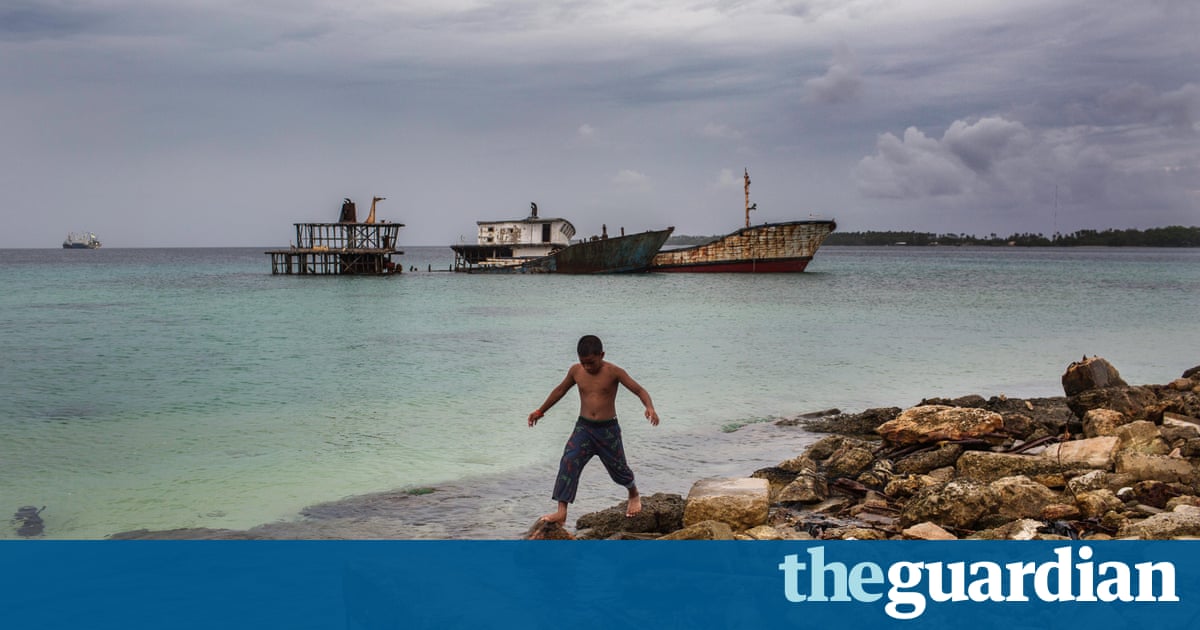
There may be music in the roar of the sea, as Byron eulogized, but the waves can also bring creeping unease. On low-lying fragments of land like the Marshall Islands, the tides are threatening to take away what they previously helped support: life.
Hilda Heine surveys the latest temporary sea wall that cleaves her property from the waves. It has been knocked down twice since February by floods and she frets about her plants that will probably face a salty demise.
Her vista would, sadly, be unremarkable in the Marshall Islands were it not for the policeman languidly guarding the corrugated metal wall Heine is the president of the Pacific island nation. Here, no one is spared the rising seas.
I need a better wall, one with rocks, Heine mutters. Her presidency will probably be defined by climate change. Heine took charge in January and immediately declared a state of emergency over a drought so dire that water was rationed in the capital, Majuro. The nation also faces the existential threat of sea level rise and, with it, the potential exodus of its population.
The numbers are increasing, of people leaving, Heine says. We see that almost every day. It concerns us. I think to a certain extent there are people who are thinking about the sea level rise and theyre wanting to make sure theyre on secure land.
There is one destination at the top of the list for departing Marshallese: the USA. More than 20,000 people from this remote sprawl of islands, located between Hawaii and Australia, are now in the US. Surprisingly, the largest Marshallese community has gathered not in New York or Los Angeles, but around Springdale, an unremarkable corner of Arkansas.
Better job prospects and a college education are major pulls, but climate change is now elbowing its way on to the list of considerations. A third of the Marshall Islands 60,000-strong population now resides in the US and some of those left behind fret that many more will follow, with the archipelagos unique culture blemished by each departure. The Marshallese government has openly worried about massive outmigration in recent years a fifth of the population left between 1999 and 2011.
As the seas rise, the pathway to the US could be closing. A compact of free association, which allows Marshallese people to live and work in the US without a visa, ends in 2023 and there are no guarantees it will be extended. Those already living in the US would be able to stay but, if the agreement isnt extended, those living in the Marshall Islands will be treated like hopeful migrants from any other country.
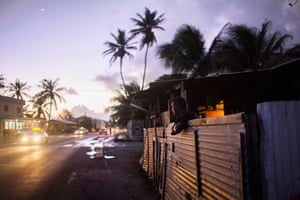
The looming expiration of the American deal means there is a concern that more people will leave, definitely, Heine concedes. Its hard being in competition with the United States. But I dont think we should give up. These are our homes.
While the Marshall Islands would fulfill most aesthetic criteria for an island paradise, its easy to see why this selection of 29 coral limestone and sand atolls and five islands, strewn across 750,000 sq miles of ocean, are so vulnerable to an ocean that is advancing due to melting glaciers and thermal expansion.
The islands are arranged in broken arcs around large lagoons. The islands are coin-flat and incredibly narrow at some points just a dozen yards separate one coast from the other.
Water is, claustrophobically, everywhere. Its handiwork is evident even in its absence graves that are sliding into the sea and spilling bones on to what remains of the beach, the Sisyphean labour of repatching flood defenses, the gnawed-away coastline releasing the determined grip of precipitously angled trees, one root at a time.
In 2014, after five-meter swells inundated Majuro for the third time in a year (historically, something that only happened once every few decades), the US Geological Survey released sobering research that shows that a mix of sea level rise and marauding waves means many atoll islands will be flooded annually, salinizing the limited freshwater resources and thus likely forcing inhabitants to abandon their islands in decades, not centuries, as previously thought.
The escape route is there, for now, but it has come at a cost. The option of moving to the US was born from the Marshall Islands misfortune of being under US administration during the cold war.
Between 1946 and 1958, the US conducted nuclear weapons testing on the islands, peppering Bikini atoll alone with 23 bombs. The largest, known as the Bravo shot, was 1,000 times more powerful than the Hiroshima bomb and vaporized three small islands.
While Bikini was evacuated, the wind blew radioactive detritus on to the inhabited atolls of Rongelap and Utrik. Within hours, the atoll was covered with a fine, white, powder-like substance, says Jeton Anjain, who led the eventual evacuation of Rongelap. No one knew it was radioactive fallout. The children played in the snow. They ate it.
Cancers, particularly of the thyroid, riddled many of those who came into contact with this radioactivity. But the wounds of dispossession are the ones that run deepest, 70 years on. The Marshallese may use faded US dollar bills, daub murals of LeBron James and Steph Curry on walls and retain the names Rita (after Rita Hayworth) and Laura (after Lauren Bacall) for the two ends of the curved Majuro island, but the relationship with America is a complicated one.
A US military base remains at Kwajalein, where unarmed missiles periodically land, fired from California. Many Marshallese serve in the US army, while the rest of the population each gets around $500 a year via a trust fund set up to compensate the harrowing nuclear tests. Still, many feel its not enough given the legacy of trauma.
It appalls me the way the US has treated the Marshallese people out here, says Jack Niedenthal, a native Pennsylvanian who came to the Marshall Islands with the Peace Corps in 1981 and never left.
Its just a really dark spot, I think, in US history. In my mind, the cold war was really fought and won by the United States on the shores of Bikini.
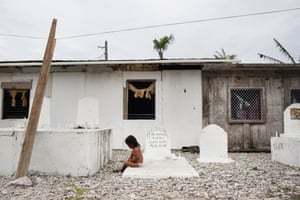
Lani Kramers grandmother was moved from Bikini as a 12-year-old. Along with other evacuees, she was dropped on to Kili, a sparse, unforgiving place that felt nowhere like home. Today, more than 800 people are crammed into a scrap of land barely a mile long, a place that depends on regularly shipped containers of food to survive.
No one from the US government has ever come to Kili and asked us: Are you guys doing OK, what can we do for you guys? says Kramer, who relentlessly ear-bashes American officials as an advocate for the Bikinian people. A lack of a US-funded cancer clinic is a particular frustration. It was so easy for them to spend millions of dollars to do the testing but why is it so hard to help the people that they moved off of Bikini atoll? A lot of people are very upset.
Kramer is part of a relatively influential Marshallese clan her husband is a leading construction magnate in Majuro. But a comfortable life in the US wont represent home, just like Kili doesnt now. The prospect of climate change finishing off what nuclear bombs started fills her with horror.
When the next uprising from the sea comes and washes away all the crops and stuff from peoples houses, then what? she says. We are going to go under. The water is going to keep coming up and were going to have nowhere else to go. Were going to have no place.
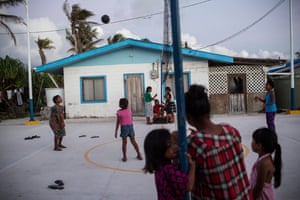
The Marshall Islands are so remote that they make you feel like a reasonably well-equipped castaway. Everything needs to be imported, meaning that tasks such as car repairs are expensive and often left to fester.
The need for speed isnt pressing given that Majuro, where half the population lives, has just one proper road, connecting two hotels, two ATMs, a couple of restaurants. The heat can be blistering all year round. Life proceeds at a plod, the cars trundling along at barely 15mph, the friendly populace showing few signs of impatience or haste.
The minimum wage is just $2 and that is if you are lucky the unemployment rate is around 36%. The country produces coconuts and breadfruit, and sells fishing licenses for the international trawlers that scour Marshallese waters for tuna, but it leans heavily upon the aid of others. Majuros police station, courts and street lighting were funded by Japan and Taiwan, the latter country getting Marshallese recognition in the UN in return.
Half of the Marshall Islands population is aged under 24 and many inevitably wonder how life would play out in the US, even if it is cloaked in the language of duty. Family bonds are sprawling yet iron-clad in Marshallese culture moving countries is largely aimed at helping the family thrive financially or socially.
A lot of people feel like the United States is the promised land, and thats where a lot of them wind up going, says Niedenthal, the former Peace Corps member who has helped administer the trust fund for years but is now packing up his office, disillusioned. Most times they buy one-way tickets. Its not a great thing to say, but to me, its almost hopeless.
I think this place is going to be gone. I feel like Im going to be one of the last people to leave. If the roads get so bad that you cant drive any more, and the peoples houses keep getting washed away, I just think people will start leaving en masse.
Its a big weekend in Springdale, Arkansas. Not only is it the Marshallese constitution day which marks the countrys independence in 1986 but it will be the first celebration to feature a beauty pageant, where young women will wear traditional clothing, read poetry and sing.
In an office located in a retail strip opposite the town hall, a clutch of young women of Marshallese descent are getting ready for the parade that will kick off the celebrations. As they get into their Marshallese flag dresses (ratak, meaning sunrise, and rlik, sunset, are the central elements of the national emblem) the room is filled with teenage American accents talking about teenage American things. One girl plays the Silento song Watch Me on her cellphone.
Springdale is almost the polar opposite of the Marshall Islands its in a landlocked state, riven with large highways and chain stores in the foothills of the Ozark mountains. But the Marshallese community, now numbering around 10,000, remains close-knit.
Legend has it they congregated at this unlikely, nondescript place because of a pioneer named John Moody, who moved to the area first through education and then work in the 1970s.
Moody toiled for nearly 20 years in the Tysons poultry plant, gutting and packing chickens. The work was smelly and dangerous Moody lost the tip of his index finger to a factory saw but the pay was a major upgrade on the Marshall Islands.
Tysons, along with fellow chicken producer Georges, remains a major employer of Marshallese people in Springdale. Walmarts headquarters, located up the road in Bentonville, is another major feature of the local economy.
The Marshallese are an object of curiosity here, but are largely accepted by a population that has has become more diverse in recent years. White, Latino and Marshallese students rub shoulders at the Har-Ber high school in Springdale, where the Marshallese passion for basketball is well appreciated. If they were taller than 5ft 3in wed have the best team around, the basketball coach admits, a little ruefully.
Melines Morris, who moved to Springdale from the Marshall Islands as a five-year-old, says she is often confused for a Hawaiian person.
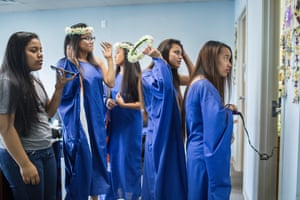
The Hispanic kids, they was like: Whats up Hawaiiana? Morris, now 18, says. Im just like: No, Im Marshallese. Im from the Marshall Islands. You can call me marshmallow.
Like many Marshallese in Springdale, Morriss family is fractured. Her mothers side of the family came to Arkansas but her father stayed in the Marshall Islands, where he has been ever since, speaking to his daughter over Skype or Facebook. Morris was plunged into a new reality, a world of McDonalds and Valentines day and Hanukkah, without being able to speak English. But she is now what many people would expect of a stereotypical American teen.
When I first started here, I always wanted to tell myself Im American, because I thought it was really cool coming here and then seeing new faces, she says. As I grew up, I knew more about my culture, and then I really liked it. I was telling myself: Wow, Im blessed to have this culture.
Morris now attempts to straddle both worlds, of Snapchat and of Marshallese customs on clothing and behavior, as well as celebrations such as kemem, a big bash thrown at the first birthday of a child. She says she was very angry when she heard about what climate change was doing to the Marshall Islands and wants to go back to help but not to live.
Arlynda Jonas, 23, is also inclined to stay in the US. Like Morris she has an American accent, which she says some Marshallese people tease her about.
I feel like Im more towards the American side than my Marshallese side but I know that I should be on my Marshallese side more strongly, she says. Its really hard. I dont want to forget my culture, my heritage or anything.
At the Constitution Day parade in Springdale, the tone is a little more defiant. The celebrations have been given a climate change theme, giving the occasion more of a protest than a party feel. Banners proclaim 70 years of exile for the Bikinian people and 1.5 to stay alive, referring to the global temperature rise that cant be breached if the Marshall Islands is to survive. Candies are tossed to onlooking children as the parade passes by.
Kenneth Kedi, speaker of the Marshallese parliament, is in Springdale to address the crowd. Kedi decries the salt-soaked soils of home, ruined for crops, and the disastrous drought. Climate change isnt shenanigans, its reality, Kedi says.
Kedi spent six years in the US and is now putting his son through school here. But he says he has mixed feelings about the diaspora, as he inspects a lei filled with candies that has been placed around his neck.
Theyre losing their identity as Marshallese, he says of the Springdale community. This is what we fear and our chiefs fear will happen, and its happening. He moved back to the Marshall Islands because he loves his country, he says, but now, that train is reversing.

Kedi, a soft-spoken man, worries that more people will flee as climate change starts to bite deeper into the fabric of Marshallese life. That they will probably move to the US is bittersweet, he says.
We believe we have been given a bad deal, he says. We make a minuscule contribution to the climate greenhouse effect but we are at the very frontline of the problems of climate change. He adds that plutonium stored at Enewetak, one of the Marshallese islands, is starting to leak into the ocean yet another American legacy.
So, yeah, were getting a bad deal, he says. We certainly are getting a bad deal.
Before the beauty pageant begins there is a lengthy church service. Marshallese people are often deeply religious most of the population is Protestant. Large sections of the address is in Marshallese but at one point the pastor blurts out in English while referencing climate change: What is going on?
Pageant contenders read out poems on climate change. One has the anguished line: We are losing our island, where will we stand? Another offers: Keep your faith in God. There follows dancing, singing and intricate, beautiful Marshallese gowns. Eventually, as we near 1am and even Marshallese patience is wearing thin, Arlynda Jonas is crowned the winner.
Its a Marshallese triumph rooted in America. Jonas would be sad if the Marshall Islands were eaten away by the waves but can see an obvious solution for the countrys people. It would be great if they did all move [to the US] because there are just so many opportunities for them here, you know? she says. I think it would be great for them to move here.
Back in Majuro, there are people who have to weigh whether to stay or go every day. For those who dont have the means or desire to relocate to the US, the future is particularly precarious.

Marlyna Laibwij, a teaching assistant in the community of Laura, has seen her neighbours abandon their coastal homes and move inland. Shells of concrete caked in vegetation dot this stretch of Majuro.
Laibwij says the increasing flooding made her sick because of worrying. Earlier this year, after the waters yet again lapped at the walls of her family home, she pleaded with the local mayor for help. He organized the construction of a sea wall, essentially rocks bundled in bags. It has provided some temporary relief.
I would have abandoned my house but I would have missed it very much, Laibwij says. I loved my home and I didnt want to abandon it.
Life is getting hard, and I believe that all of these [changes] come from the same thing, from climate change.
Should the waves advance further, however, Laibwij isnt sure if her family could remain. As we leave her house, in a moment of tender devastation, she confides: I think we can be here for another year or two. Thats what I think. What do you think? Do you think we can be here that long?
Graphics and additional reporting by Jan Diehm
- Support the Guardians independent journalism by making a contribution or becoming a member